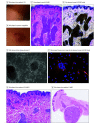Early Genetic Diagnosis of Neurofibromatosis Type 2 From Skin Plaque Plexiform Schwannomas in Childhood
- PMID: 29322178
- PMCID: PMC5885846
- DOI: 10.1001/jamadermatol.2017.5464
Early Genetic Diagnosis of Neurofibromatosis Type 2 From Skin Plaque Plexiform Schwannomas in Childhood
Erratum in
-
Missing Affiliation.JAMA Dermatol. 2018 Jul 1;154(7):852. doi: 10.1001/jamadermatol.2018.2294. JAMA Dermatol. 2018. PMID: 29998308 Free PMC article. No abstract available.
Abstract
Importance: Neurofibromatosis type 2 (NF2) is a devastating genetic condition characterized by the development of multiple tumors of the nervous system. An early diagnosis of individuals with NF2 would facilitate treatment and reduction of disease impact because most severe effects of the disease do not usually develop before adolescence. Little attention has traditionally been paid to dermatological signs in NF2. However, skin plaques are commonly seen in patients with NF2, normally appearing either at birth or early childhood, providing an opportunity for early NF2 detection and testing.
Objective: To determine the clinical utility of skin plaque identification and characterization in children for reaching an early diagnosis of patients with NF2 and to evaluate their molecular pathogenesis and their use in the genetic diagnostics of NF2.
Design, setting, and participants: Diagnostic test study by the histological and genetic characterization of skin plaques from patients with NF2. Patients were 7 individuals with NF2 or clinical suspicion of NF2 treated at the Spanish Reference Center on Phakomatoses.
Main outcomes and measures: Histological evaluation of all skin plaques was performed. Fresh skin plaques were cultured to obtain Schwann cells and the NF2 gene was genetically analyzed. For all 7 patients, NF2 clinical history was reviewed.
Results: In all 7 patients (4 male and 3 female), all skin plaques analyzed were histologically characterized as plexiform schwannomas. Genetic analysis of primary Schwann cell cultures derived from them allowed the identification of a constitutional and a somatic NF2 mutation. Genetic testing allowed the early diagnosis of NF2 in a child only exhibiting the presence of skin plaques. Most of the patients with NF2 analyzed had an early presentation of skin plaques and a severe NF2 phenotype.
Conclusions and relevance: This work emphasizes the clinical utility of a careful dermatological inspection and the correct identification of skin plaques in children for an early diagnosis of NF2. We show for the first time that Schwann cells derived from skin plaque plexiform schwannomas bear the double inactivation of the NF2 gene and thus constitute an excellent source of tissue for genetic testing, especially in the context of mosaicism.
Conflict of interest statement
Figures


References
-
- Lloyd SK, Evans DG. Neurofibromatosis type 2 (NF2): diagnosis and management. Handb Clin Neurol. 2013;115:957-967. - PubMed
-
- Mautner VF, Lindenau M, Baser ME, Kluwe L, Gottschalk J. Skin abnormalities in neurofibromatosis 2. Arch Dermatol. 1997;133(12):1539-1543. - PubMed
-
- Hexter A, Jones A, Joe H, et al. ; English Specialist NF2 Research Group . Clinical and molecular predictors of mortality in neurofibromatosis 2: a UK national analysis of 1192 patients. J Med Genet. 2015;52(10):699-705. - PubMed
-
- Ruggieri M, Iannetti P, Polizzi A, et al. . Earliest clinical manifestations and natural history of neurofibromatosis type 2 (NF2) in childhood: a study of 24 patients. Neuropediatrics. 2005;36(1):21-34. - PubMed
-
- Nunes F, MacCollin M. Neurofibromatosis 2 in the pediatric population. J Child Neurol. 2003;18(10):718-724. - PubMed
Publication types
MeSH terms
LinkOut - more resources
Full Text Sources
Other Literature Sources
Medical
Research Materials
Miscellaneous

